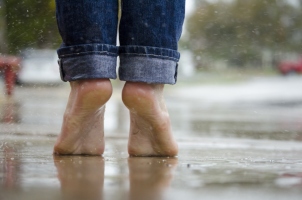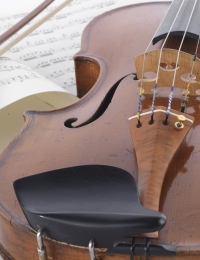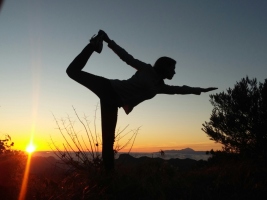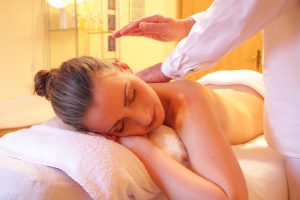
|
Posture caused problems in the viola play and prevention |
by Mascha Seitz
 Man has far removed from his nature.
Man has far removed from his nature.We are no longer outside most of the time, rarely climb trees and barely run further than the distance to our car. Our nature would be, if we believe today's researchers, to walk about 50 kilometers on foot every day. Barefoot and, of course, not only on stone and asphalt.
Also the long periods of sitting in front of the computer can hardly be healthy for us. Who does not know the resulting "office diseases"?
The same is true for playing an instrument for hours on end. The viola for example, beautiful as it is, often gives the player physical problems in the long run. The permanent one-sided load is a big challenge for the body. In order to get away from it, one must first of all pay attention to his posture
 Typical problems and their causes
Typical problems and their causes
Typically, musicians complain about various ailments, depending on the instrument.Thus, pianists often have shoulder and back problems, tendonitis, or carpal tunnel syndrome. The wind instruments (especially those with heavier instruments) suffer from tension in the upper back and shoulders. Frequently the load on the mouth muscles also affects the jaw, which can lead to further complaints. In addition, there is a hearing stress which cannot be underestimated in the case of the one or the other instrument.
 Where are the problems with the strings?
Where are the problems with the strings?Since the viola is longer than the violin, the player's left arm has a larger angle. While the elbow is sometimes supported when playing the violin, it is constantly in the air when playing the viola. As a result, the tension is pulled through the arm up to the back of the neck where, as in the shoulder, tensions occur. The outer rotation of the upper arm (which naturally rotates tendencially towards the inside) while playing lifts the shoulder blade to the front / top and thus loads the shoulder belt.
In addition, the fingers are stretched longer when gripping the notes than with the violin. The continuous load often leads to a "tennis arm" and tendonitis.
Of course the viola is not only bigger but also heavier than the violin, which can be felt with a longer play. Depending on the position especially for the jaw holding the instrument. Therefore, strings often suffer from jaw tensions, which can result in headache, dizziness, and nightly teeth grinding.
Supporting the instrument with the head uses pressure if held in the wrong position and can cause neck problems such as tension, cervical spine syndromes, shifted or twisted cervical vertebrae (scoliosis). These lead to headaches, dizziness and other inconveniences in part similar to the jaw problems.

The correct posture, shoulder rests and chin rest
To prevent these health problems the correct posture is essential for violists and violinists. This should be properly learned by the age of 20 at the latest, otherwise it's unlikely that the posture can be corrected.
Thus the head should be slightly turned to the left while playing, it should not be tilted. The most important thing is that the shoulders are not stretched in front or raised. The back is upright and stable, and the spine is not curved.
For the shoulder and neck problems, properly selected and adjusted shoulder and chin rests are essential. Finally, the viola should be held without additional pressure from the head. Today, there are even workshops that manufacture custom-made chin restraints and shoulder rests according to previously removed plaster impressions.
A violist we know had clamped a vein through the wrongly adjusted shoulder rest while playing, so that it came several times to Cardiac arrhythmia. In the case of such unusual problems, it is sometimes not easy to see the connection between the ailment and playing an instrument, but this example underlines the importance of the right shoulder rest.
 Do yourself something good - compensation options
Do yourself something good - compensation options
What to do to prevent the discomforts? Our tips:Muscle Building!
The basis for healthy play is the strengthening of the back, shoulder and neck muscles. It is especially important for professional musicians not to neglect this. Although not everyone enjoys sporting activities, the training of these areas for violists pays off a lot!
Prevention Through Sport!
For the strength and stretching of the muscles, regular swimming and yoga are particularly recommended.
The "five Tibetans" can create a good physical basis for our athletes, but also for people of high age or with physical limitations. These exercises, which have their origin in classical Hatha yoga, improve, among other things, the elasticity of the spine. Every day with just 10-20 minutes it is probably the easiest way to do something for your health.
If you want to learn more about the "five Tibetans", you can visit https://en.wikipedia.org/wiki
Stretch!
Stretching exercises, in particular from the fingers to the neck, are simple ways to help the body before playing but also during breaks. In particular, those who practice yoga will already have come into contact with some ap
 propriate stretching exercises. It is important to learn these from qualified trainers, since wrongly practiced exercises can have negative consequences.
propriate stretching exercises. It is important to learn these from qualified trainers, since wrongly practiced exercises can have negative consequences.Physical Therapy!
Of course, these exercises and sports proposals are preventive. There are even physical therapists specialized in musicians and corresponding therapies for health problems that have already occurred.
And last but not least, indulge in a massage now and then...
Beatriz Ruiz Villameriel wrote on 27.01.2018 at 19:17
Hola, soy violista y llevo muchos años queriendo tener una barbada y almohadilla personalizada, en vuestro articulo hablais de lugares donde se lleva a cabo, podriais decirme donde?'Un saludo y muchas gracias de antemano.
Marianne Ranzenhofer (Facebook) wrote on 11.02.2017 at 10:13
Yay Mary! Playing the viola IS FUN!!!
Mary A. Molitor (Facebook) wrote on 11.02.2017 at 10:01
If you have headaches, and tention from playing the Viola...Get a smaller one, don't practice 9 hrs or go for a walk! It's supposed to be Fun!
Mary Jane Porter-Linden (Facebook) wrote on 11.02.2017 at 09:03
The article does not show what a correct posture is. The description is not accurate. What is important is that the chin rest is comfortable and fits the player. If the violist has to play for a project that requires long periods of time playing, like an athlete, they have to exercise and get in condition to prevent injury. The viola is larger and heavier than a violin and it takes more strength and endurance to play for long periods of time. Posture plays a roll in finding balance and optimal range of motion while playing. Physical problems come from over use of certain muscles and tendons especially when they are out of shape. Other problems with the neck and spine could develop over many years of playing.
| Blog overview |
» To the blog list
| Newsletter |
 Do you don't want to miss any news regarding viola anymore? Our newsletter will keep you informed.
Do you don't want to miss any news regarding viola anymore? Our newsletter will keep you informed.» Subscribe to our Newsletter for free
 Visit us on Facebook. The news articles are also posted.
Visit us on Facebook. The news articles are also posted.» To Facebook
a violist since childhood , learning/teaching the Alexander Technique college on, now a body worker specializing in musicians. Look me up and let me guide you! I am in LA.